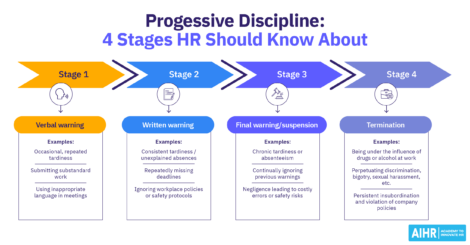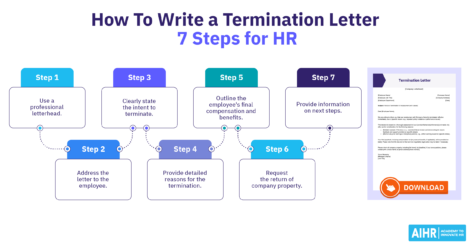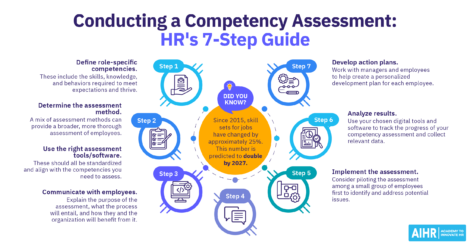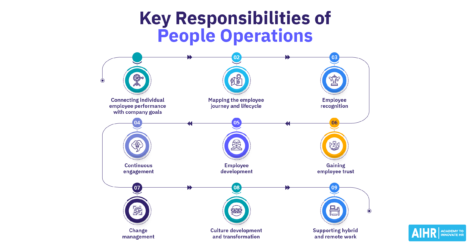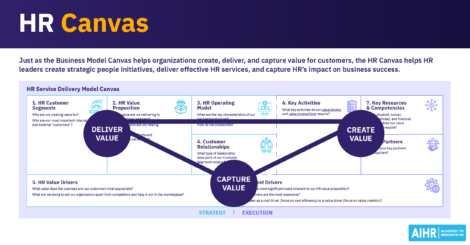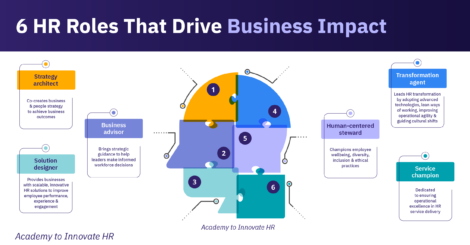27 Key Drivers of Employee Engagement To Benefit Your Workforce
High employee engagement can make a business 21% more profitable, yet only one-third of employees are engaged. How can you drive employee engagement to benefit your organization and its workforce?

Understanding the key drivers of employee engagement is crucial for keeping your workforce motivated and productive. These drivers help HR professionals identify what drives engagement, whether it is recognition, professional development, or a positive work environment.
By focusing on these factors, you can create a culture where employees feel valued and invested in their work, leading to better performance and retention.
Contents
What is employee engagement?
What drives employee engagement?
27 drivers of employee engagement HR should harness
What is employee engagement?
Employee engagement is the emotional and psychological connection employees have to their work and employers. It influences their level of motivation, productivity, and satisfaction in their roles.
Engaged employees feel invested in the company’s success, driving innovation and better results. They’re also less likely to resign or leave on a bad note. In contrast, low engagement can lead to decreased productivity and higher turnover rates.
What drives employee engagement?
Key drivers of employee engagement include leadership quality, communication, recognition, opportunities for professional growth, and a generally positive work environment. Employees who trust their leaders and feel supported are more likely to be engaged.
Additionally, recognition and rewards for outstanding performance can significantly boost engagement. An Achievers survey found that 69% of employees would work harder if they felt their employers appreciated their efforts.
HR’s role in driving employee engagement
HR professionals play a strategic role in driving employee engagement by identifying, implementing, and optimizing the key drivers that contribute to a more engaged workforce. They don’t just facilitate but also develop employee engagement strategies, ensuring the organization’s culture, policies, and practices foster employee commitment.
A good example is Salesforce’s ‘Ohana-inspired culture, which emphasizes collaboration, inclusivity, and wellbeing. Because of this focus on developing its culture, Salesforce has reported that its employees are more engaged and productive.
HR tip
Promote work-life integration: Encourage employees to blend work and personal life in ways that suit them. Offer options like hybrid working models or “flex Fridays”, where employees can wrap up their week early if they’ve met their goals. This flexibility helps employees manage their time better, reduce burnout, and increase overall engagement.
27 drivers of employee engagement HR should harness
Driver 1: Leadership and management quality
Effective leadership and management set the tone, culture, and direction of the organization. Leaders who are communicative, supportive, and transparent can significantly boost employee motivation and engagement.
Conversely, poor leadership can lead to disengagement, reduced productivity, and increased turnover. According to Gallup, managers account for at least 70% of the variance in employee engagement scores.
Try this
- Offer leadership development programs: To enhance management effectiveness, invest in leadership training that focuses on emotional intelligence, communication, and employee coaching.
- Implement 360-degree feedback: Implement a feedback mechanism that allows employees to provide anonymous feedback to their managers. This will help identify areas for improvement.
- Encourage regular check-ins: Encourage managers to have consistent one-on-one meetings with their team members to build trust, provide guidance, and show appreciation.
Driver 2: Meaningful work
Employees are more engaged and motivated when they find their work meaningful and aligned with their personal values. According to a SHRM survey, 89% of employees believe meaningful work is important to their job satisfaction.
Try this
- Consider Job enrichment: Redesign jobs to include more relevant responsibilities and opportunities so employees can see the direct impact of their work.
- Communicate purpose-driven goals: Ensure the organization’s mission and goals are clearly communicated and that employees understand their importance in the bigger picture.
- Encourage employee involvement: Involve employees in decision-making processes related to projects they are passionate about.
Driver 3: Recognition and rewards
Recognition and rewards are a vital part of any employee engagement plan. According to a study by Deloitte, companies that implement effective recognition programs have 31% lower voluntary turnover than those that don’t.
Try this
- Offer personalized recognition: Tailor recognition efforts to individual preferences, whether for monetary or non-monetary rewards (or a mix of both).
- Implement peer-to-peer recognition: Create a platform where employees can recognize their peers to encourage a culture of appreciation.
- Provide timely recognition: Ensure recognition is timely and closely linked to each achievement, as this makes it more impactful.
Driver 4: Professional development opportunities
Employees are more engaged when they have access to professional growth and development opportunities. Offering training, mentorship, and career advancement paths shows employees the organization is invested in their future.
For instance, LinkedIn research reveals that 94% of employees would stay at a company longer if it invested in their career development.
Try this
- Encourage continuous learning: Provide access to workshops, online courses, and seminars to facilitate skill development.
- Develop career pathing: Work with employees to create clear career paths that outline potential advancement opportunities for them within the organization.
- Implement mentorship programs: Pair employees with mentors who can offer guidance, support, and advice on career progression.
Driver 5: Work-life balance
When employees have the flexibility to better manage their personal and professional lives, they are more satisfied and productive. In fact, 91% of employees in organizations that support wellbeing initiatives say they are motivated to achieve their best at work.
Try this
- Offer flexible working hours: Offer flexible schedules or remote work options to accommodate different lifestyles and responsibilities.
- Provide wellness programs: Implement wellness programs that support physical and mental health, such as gym memberships, meditation sessions, or counseling services.
- Encourage time off: Emphasize the importance of taking breaks and vacations to recharge and avoid burnout.
Driver 6: Company culture
Positive organizational culture creates an environment where employees feel valued, respected, and motivated. Zappos is a great example of this. The company emphasizes employee happiness and an enjoyable work environment. This has led to significant revenue growth and a loyal customer base.
Try this
- Focus on cultural alignment: Ensure the company’s values and mission are clearly communicated to employees and reflected in daily operations.
- Involve employees in culture building: Involve employees in defining and evolving the company culture to ensure it resonates with the workforce.
- Celebrate cultural milestones: Recognize and celebrate milestones that reinforce company culture, such as diversity days, anniversaries, and community events.
“Another key aspect of positive organizational culture is recognizing and accepting micro-cultures. This acceptance will enable HR to create policies that are less narrow and more inclusive. Managerial development to build the right team culture would also be a great addition (to company culture).”

Driver 7: Job security
Job security allows employees to focus on their work without worrying about uncertainty. When employees feel secure in their positions, they are more likely to be engaged and committed to the organization.
Try this
- Ensure communication is transparent: Openly discuss the company’s financial health and future plans to alleviate concerns about job security.
- Offer long-term contracts: Offer long-term contracts or clearly defined employment terms to provide greater stability.
- Provide support during transitions: If retrenchment or restructuring is necessary, provide outplacement services, counseling, and clear communication to support affected employees.
Driver 8: Autonomy and empowerment
When employees are given autonomy and empowered to make decisions, they feel trusted and valued, which significantly boosts engagement. Autonomy allows employees to take ownership of their work and innovate without constant supervision.
For instance, GitHub allows employees to choose the projects they work on and the teams they collaborate with. This helps employees feel a greater sense of ownership and responsibility, which can boost creativity and innovation.
Try this
- Enable confident decision-making: Encourage employees to make decisions and provide the necessary resources and support to help them do so.
- Offer autonomy in work schedules: Allow employees to manage their own schedules and work in a way that suits their productivity patterns.
- Encourage innovation: Create an environment that prioritizes psychological safety, so employees feel confident to propose new ideas and take calculated risks.
Driver 9: Effective communication
Effective communication shows employees their managers and colleagues respect them and are willing to be accountable. Clear and consistent communication from leadership also helps employees understand the organization’s goals and expectations, and their role in achieving them.
Try this
- Provide regular updates: Provide regular updates on company performance, goals, and changes to keep employees informed and engaged.
- Encourage an open-door policy: Encourage an open-door policy where employees feel comfortable sharing their ideas, concerns, and feedback.
- Use multiple communication channels: Use various communication channels such as emails, meetings, and internal social networks to reach all employees promptly.
HR tip
Implement cross-training programs: Offer cross-training opportunities to allow employees to learn skills from different departments. This not only broadens their skill set but also gives them a better understanding of the company, fostering a sense of ownership and improving engagement.
Driver 10: Teamwork and collaboration
Teamwork and collaboration create a sense of community and shared purpose. When employees work well together, they feel more connected to their colleagues and the organization.
Spotify, for example, implemented a squad-based structure where small, cross-functional teams would work independently. The company demonstrated how an innovative organizational structure could enhance agility, innovation, and employee satisfaction.
Try this
- Organize team-building activities: Organize regular team-building activities to strengthen relationships and improve collaboration.
- Enable cross-functional teams: Encourage cross-functional teams to work on projects that require diverse skills and perspectives.
- Provide collaborative tools: Provide tools and platforms that facilitate collaboration, such as project management software and communication apps.
Learn how to drive and sustain employee engagement
Knowing what drives employee engagement is vital but knowing how to use these drivers is even more important.
In AIHR’s Talent Management & Succession Planning Certificate Program, you’ll learn how to drive employee engagement by creating an environment for talent to thrive throughout the employee lifecycle.
This online, self-paced Certificate Program will teach you essential skills for driving employee engagement. This includes effective employer branding, and leveraging career management and talent mobility to keep talent engaged for the long term.
Driver 11: Fair compensation
Fair compensation reflects how much the organization values its employees. Competitive pay and benefits packages are essential to attracting and retaining top talent.
Try this
- Implement market-based pay scales: Regularly review and adjust pay scales to ensure their competitiveness with industry standards.
- Develop transparent pay policies: Communicate compensation policies clearly and ensure pay decisions are fair and consistent.
- Offer comprehensive benefits: Offer a comprehensive benefits package that includes health insurance, retirement plans, and other perks employees value.
Driver 12: Employee feedback and involvement
Involving employees in decision-making and encouraging them to provide feedback is crucial for driving engagement. When employees feel the organization values their opinions, they are more likely to stay with the company longer.
Try this
- Conduct meaningful surveys: Use periodic employee surveys to gather feedback on various aspects of work based on organizational strategy.
- Establish feedback loops: Use surveys to build a culture that enables employees to share open and honest feedback.
- Set up an employee engagement committee: Create an employee engagement committee to facilitate participation in decision-making processes and the co-creation of strategy, communications, and change implementation.
Driver 13: Diversity, Equity, Inclusion, and Belonging (DEIB)
DEIB creates a workplace where everyone feels respected and valued. It also enhances creativity, innovation, and a sense of belonging. McKinsey reports that companies with high levels of diversity are 35% more likely to have financial returns above their national industry medians.
Try this
- Ensure inclusive hiring practices: Implement hiring practices that promote diversity and ensure all candidates are evaluated fairly.
- Develop diversity training: Offer regular training on diversity and inclusion to educate employees and promote an inclusive culture.
- Support employee resource groups (ERGs): Support ERGs that provide a platform for employees from different backgrounds to connect and share their experiences with one another.
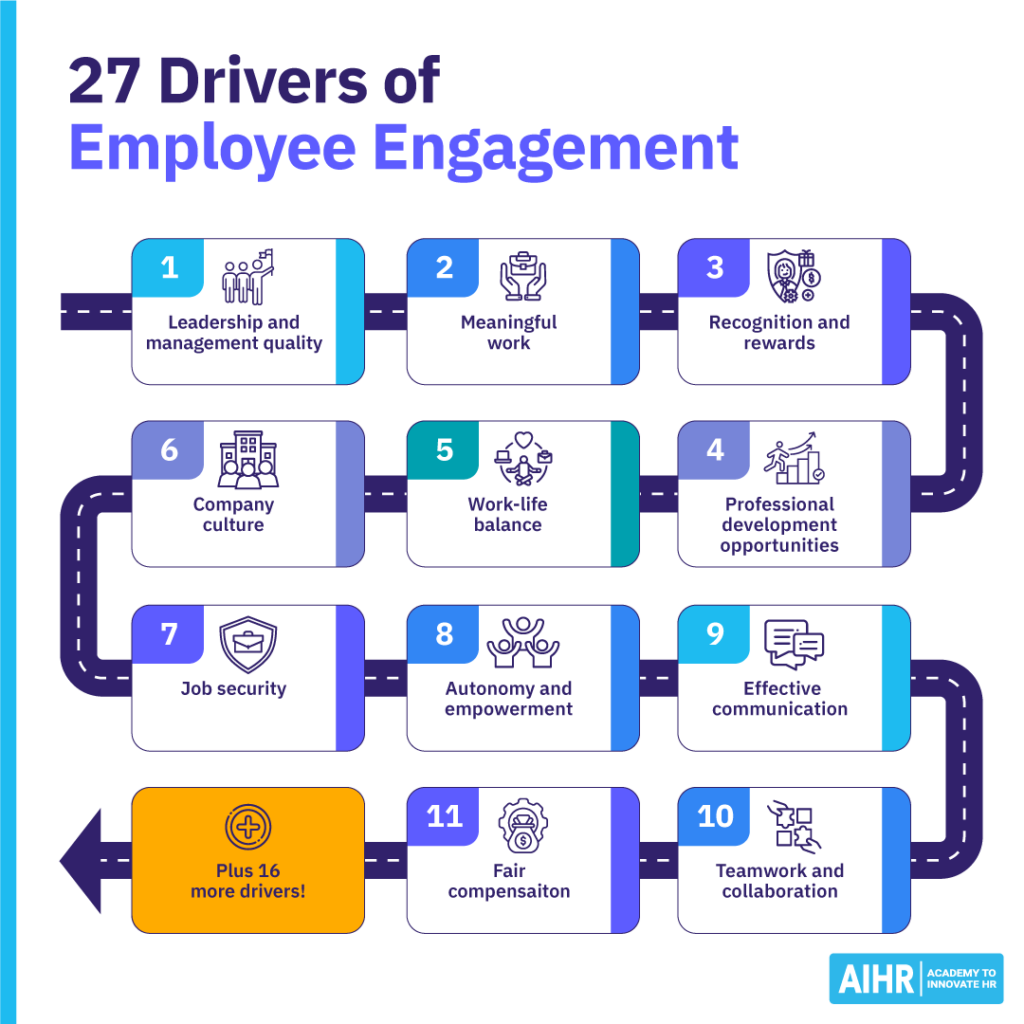
Driver 14: Purpose and vision alignment
When employees understand and align with the organization’s purpose and vision, they are more likely to be engaged. A clear, compelling vision gives employees a sense of direction and purpose in their work.
Try this
- Communicate the mission statement: Regularly communicate the company’s mission and vision to ensure all employees understand and connect with it.
- Ensure role alignment: Help employees see how their specific roles contribute to the organization’s overall vision and purpose.
- Encourage purpose-driven projects: Encourage employees to participate in projects that align with their personal values and the company’s mission.
- Establish common interest groups: Set up common interest groups that bring together employees with common interests to engage with one another outside of their work tasks and projects.
Driver 15: Social relationships at work
When employees have strong relationships with their colleagues, they feel more connected to the organization and more motivated to collaborate and succeed.
Try this
- Organize social events: Organize regular social events, such as team lunches or after-work gatherings, to strengthen relationships among employees.
- Develop mentorship programs: Pair employees with mentors or buddies to help new hires integrate into the team and build strong connections.
- Create collaborative spaces: Create spaces in the office where employees can easily interact and collaborate informally.
Driver 16: Recognition of individual and team contributions
Employees who feel their efforts are acknowledged are more likely to be motivated and continue contributing at a high level. HubSpot has a strong culture of recognizing and celebrating employee achievements (e.g., through peer-to-peer recognition programs) to ensure employees feel valued and appreciated.
Try this
- Develop recognition programs: Implement formal employee recognition programs that highlight individual and team achievements on a regular basis.
- Encourage public acknowledgment: Use company meetings, social media networks like LinkedIn, or newsletters to publicly acknowledge outstanding contributions from employees and teams.
- Develop personalized rewards: Offer personalized rewards aligned with the employee’s preferences and interests.
Driver 17: Physical and mental wellbeing support
Employees who feel their employers prioritize their wellbeing are more likely to be engaged and productive. The American Psychological Association reports that 89% of workers whose employers support wellbeing initiatives are more likely to recommend their companies as good places to work.
Try this
- Develop wellness programs: Offer wellness programs that include gym memberships, mental health support, and healthy eating options.
- Offer mental health days: Allow employees to take mental health days as needed to recharge and avoid burnout.
- Improve workplace ergonomics: Ensure the workplace is designed ergonomically to reduce physical strain and discomfort.
- Offer soft skills training to managers: Help managers develop empathic and compassionate management styles to help them understand and address employees’ needs and concerns. This can lead to improved wellbeing and job satisfaction.
Driver 18: Encouragement of innovation and creativity
Encouraging innovation and creativity among employees is a powerful driver of engagement. When employees feel that their ideas are valued and that they can contribute creatively to the organization, they are more likely to be engaged.
Try this
- Offer idea platforms: Create platforms where employees can submit and share innovative ideas, such as suggestion boxes or innovation hubs.
- Organize hackathons and innovation days: Organize events like hackathons or innovation days, when employees can work on creative projects outside their usual tasks.
- Reward innovation: Recognize and reward employees who contribute innovative ideas that drive the business forward.
HR tip
Create a mentorship network: Establish a formal mentorship program that allows employees to connect with more experienced colleagues. This paves the way for professional growth, valuable guidance, and strong interpersonal connections, all of which contribute to higher engagement levels.
Driver 19: Organizational transparency and integrity
When employees trust their employers to be honest and transparent, they are more likely to be engaged and loyal. Companies like Buffer practice radical transparency by sharing company financials, salaries, and decision-making processes with all employees.
Try this
- Encourage transparent communication: Ensure that company decisions, especially those affecting employees, are communicated transparently and honestly.
- Promote ethical practices: Promote and adhere to ethical business practices that reflect the organization’s values.
- Encourage open financials: Encourage the sharing of financial performance and other key metrics with employees to build trust and transparency.
Driver 20: Career advancement opportunities
Employees are more engaged when they see a clear path for career progression within the organization. Providing opportunities for advancement not only motivates employees but also helps retain top talent.
In fact, 47% of U.S. employees rate career advancement opportunities as very important to their job satisfaction and engagement, with the figure rising to 89% among millennials.
Try this
- Offer internal promotions: Prioritize internal promotions to show employees the organization values their growth.
- Provide clear advancement criteria: Define and clearly communicate the criteria for promotions and career progression so employees know what to do to achieve this.
- Develop mentorship for growth: Establish mentorship programs to help employees develop the skills needed for future roles.
- Enable lateral growth: Create opportunities for employees to grow laterally and cross-functionally. This will help enhance the employee experience and their future growth opportunities.
Driver 21: Performance management
Effective performance management ensures employees receive regular feedback, set clear goals, and have enough support for their development. When HR and managers handle this process well, employees feel motivated and aligned with the organization’s objectives.
Try this
- Encourage regular check-ins: Implement regular performance check-ins instead of annual reviews to provide timely feedback and support to employees.
- Create development plans: Create personalized development plans to help employees reach their full potential.
- Ensure transparent performance assessment practices: Provide transparency on performance assessment practices to build trust and engagement with employees.
Driver 22: Employee empowerment
When you empower employees with the authority and resources to make decisions, they feel trusted and are more likely to take ownership of their work. This will, in turn, lead to higher motivation and productivity.
Try this
- Encourage delegation of authority: Encourage managers to delegate decision-making authority to their teams where appropriate.
- Provide training for empowerment: Provide training that equips employees with the skills and confidence to make decisions independently.
- Encourage initiative: Develop a culture that encourages employees to take initiative and lead projects.
Driver 23: Recognition of work and life milestones
Recognizing significant personal milestones, such as birthdays, anniversaries, or personal achievements, can enhance engagement by making employees feel valued on a personal level. This builds a sense of belonging and strengthens the connection between employee and employer.
Try this
- Celebrate milestones: Implement a system to announce and celebrate personal milestones, such as work anniversaries or birthdays company-wide.
- Provide personalized gestures: Offer personalized gestures like, sending cards or gifts to acknowledge significant life events or work achievements.
- Encourage public acknowledgment: Recognize these milestones in company meetings or e-newsletters to show appreciation.
Driver 24: Employee resource availability
Having the necessary resources to do their jobs efficiently is a significant driver of employee engagement. When employees have access to the right tools, technology, and support, they can be more productive and satisfied with their work.
Try this
- Assess employee resources: Regularly assess whether employees have the resources they need to perform their jobs effectively.
- Technology upgrades: Invest in the latest technology and tools to maximize productivity and minimize frustration.
- Offer support systems: Ensure employees have easy access to support systems, such as IT help desks, to resolve issues quickly.
Driver 25: Organizational reputation
An organization’s internal and external reputation plays a crucial role in driving employee engagement. Employees who are happy to work for a company with a strong reputation are more likely to be engaged and act as brand ambassadors.
According to a Glassdoor survey, 84% of employees would consider leaving their current jobs if offered a role at a company with a better reputation.
Try this
- Promote company values: Regularly communicate the company’s values, achievements, and community involvement to employees.
- Highlight success stories: Share success stories and positive customer feedback to reinforce the organization’s reputation.
- Suppport employee advocacy programs: Encourage employees to share their positive experiences on social media and other platforms.
Driver 26: Technological enablement
When employees have access to modern, user-friendly technology to streamline work processes and improve communication, they are more efficient and satisfied with their work environment.
Try this
- Invest in technology: Invest in the latest technology to help enhance productivity and support remote workers.
- Provide training on new tools: Provide comprehensive training on new tools and systems to ensure employees can use them effectively.
- Create technology feedback loops: Create feedback loops where employees can suggest improvements or report issues with the technology they use.
Driver 27: Corporate social responsibility (CSR) initiatives
Involvement in CSR initiatives can help employees feel their work positively impacts society. Organizations that actively participate in CSR are more likely to attract and retain engaged employees.
In fact, millennials are unlikely to accept a job offer from a company that doesn’t have strong CSR practices. Transparency, ethical practices, and sustainability influence their job choices and company loyalty.
Try this
- Encourage volunteerism: Provide paid time off for employees to volunteer for causes they care about.
- Implement CSR programs: Develop CSR programs that align with the company’s values and involve employees in these initiatives.
- Communicate impact: Regularly communicate the impact of the organization’s CSR efforts to employees, reinforcing their positive contribution to society.
To sum up
Understanding what makes employees tick is important for making your company’s workforce happy and productive. When people are genuinely engaged at work, it’s a win-win: the organization does better, and so do they.
But it’s not just about ensuring employees are content — it’s about tapping into what truly motivates them. Recognition for their efforts, growth opportunities, and a positive environment make a significant difference.
Engaged employees also tend to put in extra effort, propose great ideas, and stick around longer. So, figuring out what drives engagement and prioritizing it is key to creating a workplace where everyone can thrive.
Learn more
Related articles
Are you ready for the future of HR?
Learn modern and relevant HR skills, online







